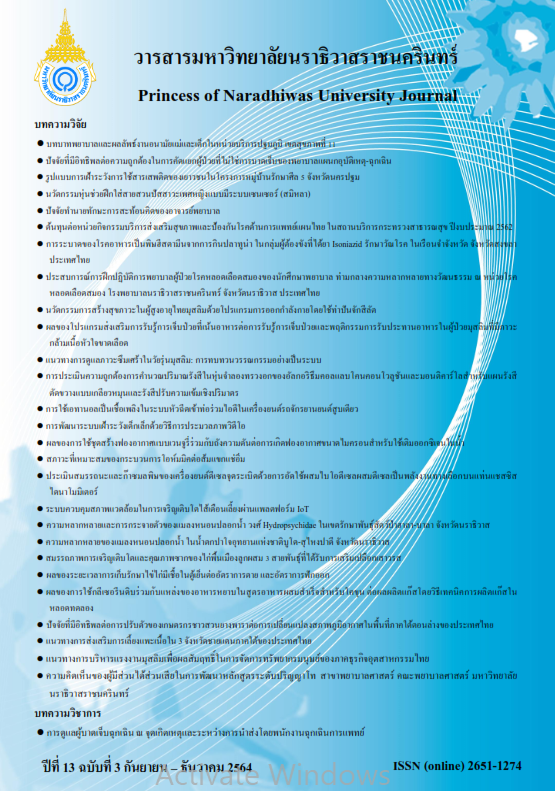Trauma Patient Care at the Scene and During Transportation by Emergency Medical Technician Personnel
Keywords:
Trauma patients care, Prehospital care, Emergency medical technician personnel, At scene care, Intra-hospital careAbstract
Emergency injury is a life-threatening condition. It can happen at any time and can happen to any age. This resulted in massive loss of life and disability. Currently, the trauma patient care system has become more advanced. In each area, emergency operations teams have been developed to provide assistance at the scene of incidents and during transfer in accordance with the area of assistance aiming to provide trauma patient access to timely medical care. The emergency medical technician personnel are considered to be key personnel in emergency operations and to be a person in an area near the scene with specialized knowledge and skills in emergency injury assessment. In addition, the emergency medical technician personnel can provide primary care at the scene and during transfer to a medical facility located in a remote area continuously, appropriately, and efficiently for trauma patients. Resulting in reduced the lass of mortality, disability proportionally and health care costs of health care system. The review of emergency operations data found that basic emergency operations, which consist of emergency medical technician personnel as the number of operations, have increased and emergency medical technician personnel in basic life support unit are considered as significant people in helping the trauma patients. The author will explain the roles of emergency medical technician personnel in trauma patient care at the scene and during transfer in four areas as follows: (1) Emergency notification from the Command Center 1669, (2) Assessment and care for accident victims at the accident scenes, (3) Resuscitation for accident victims that have experienced cardiac arrest at the scene of emergency accidents and (4) the transport and care during transfer. The findings can be used as guidelines for emergency medical technician personnel to apply in appropriate contexts of work in the future.
References
Ameenoh K. (2017). Development of quality of emergency medical services, Nathawi District Network Songkhla Province. In Khanittha Phusimungkhun, Pornthida Yamphakhon, Suwapat Apinyanon, and Ura Suwanrak (editor), National Academic of Emergency Medicine 2017, Bangkok, National Institute for Emergency Medicine. (in Thai).
Centers for Disease Control and Prevention (2020). CDC Health Information for International Travel (Yellow Book 2020). Retrieved May 25, 2020from https://wwwnc.cdc.gov/travel/yellowbook /2020/travel-by-air-land-sea/road-and-traffic-safety.
Chotiklum P, & Viensiao, W. (2010). Standards and guidelines for emergency medical systems. Nonthaburi. National Institute for Emergency Medicine. (in Thai).
Glen, J., Constanti, M., & Brohi, K. (2016). Assessment and initial management of major trauma: summary of NICE guidance. The British Medical Journal, 353.
Kleinman, M.E., Goldberger, Z.D., Rea, T., Swor, R.A., Bobrow, B.J., Brennan, E.E., ... Travers, A. H. (2018). 2017 American Heart Association focused update on adult basic life support and cardiopulmonary resuscitation quality: an update to the American heart association guidelines for cardiopulmonary resuscitation and emergency cardiovascular care. Circulation, 137(1), e7-e13.
Murad, M.K., Larsen, S., & Husum, H. (2012). Prehospital trauma care reduces mortality. Ten-year results from a time-cohort and trauma audit study in Iraq. Scandinavian Journal of Trauma, Resuscitation and Emergency Medicine, 20(1), 1-10.
National Institute for Emergency Medicine. (2010). Standards and regulations on the emergency medical system. Nonthaburi. National Institute for Emergency Medicine. (in Thai).
National Institute for Emergency Medicine. (2016). Development of national emergency medicine master plan no. 3, 2017 - 2021. National Institute for Emergency Medicine. Union creation.
National Institute of Emergency Medicine. (2018). Information Technology for Emergency Medical System (ITEM). Retrieved May 25, 2018 from https://goo.gl/JmCBLP
Office of Transport and Traffic Policy and Planning. (2019). Road accident situation analysis report of ministry of transport 2019. Ministry of transport. Bangkok. (in Thai).
Samrit, S., Bunyawee, E., & Wanapa, B. (2013). International Experiences on Emergency Medical Services And Lessons Learned for Thailand. Nonthaburi: Health Systems Research Institute Networks. (in Thai).
The National Association of Emergency Medical Technicians [NAEMT]. (2018). Prehospital Trauma Life Support (PHTLS) ninth edition. The United State of America.
Varga, E., Endre, E., Koszo, B., Peto, Z., Agoston, Z., Gyura, E., ... Suveges, G. (2016). Advanced Trauma Life Support (ATLS) in Hungary; The first 10 years. Bulletin of Emergency & Trauma, 4(1), 48-50.
Wangsri, K. (2013). The EMS system in Thailand. Srinagarind Medicine Journal, 28(4), 69-73.
Weerakhachon, P., Chanthamolee, S., Suwan, P., & Srisupanan, M. (2017). Development of emergency operation model for the emergency medical technician in border southern provinces. The Southern College Network Journal of Nursing and Public Health, 4(3), 87-103.
World Health Organization (2018). Global Status Report on Road Safety 2018. Retrieved May 25 2020 fromhttps://www.who.int/violence_injury_prevention/road_safety_status/2018/en/external icon.




